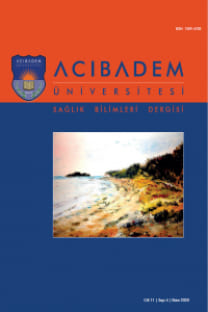Açık Glob Yaralanmalarında Orbital Bilgisayarlı Tomografinin Tanı Koymadaki Duyarlılığı ve Buna Etki Eden Faktörlerin Değerlendirilmesi
Determining the Sensitivity in the Diagnosis of Preoperative Orbital Computed Tomography in Patients With Open Globe Injury and Evaluating the Affecting Factors
___
- 1. Crowell EL, Koduri VA, Supsupin EP, Klinglesmith RE, Chuang AZ, Kim G, Baker LA, Feldman RM, Blieden LS. Accuracy of Computed Tomography Imaging Criteria in the Diagnosis of Adult Open Globe Injuries by Neuroradiology and Ophthalmology. Acad Emerg Med. 2017;24:1072-1079.
- 2. Kalaycı M, Çetinkaya E. Somali Popülasyonundaki Açık Glob Yaralanmalarının Epidemiyolojisi. Acıbadem Univ. Sağlık Bilim. Derg. 2021;12:92-196.
- 3. Kuhn F, Morris R, Witherspoon CD. Birmingham Eye Trauma Terminology (BETT): terminology and classification of mechanical eye injuries. Ophthalmol Clin North Am 2002;15:139–143.
- 4. Kuhn F, Morris R, Witherspoon CD, Heimann K, Jeffers JB, Treister G. A standardized classification of ocular trauma. Ophthalmology 1996;103:240–243.
- 5. Russell SR, Olsen KR, Folk JC. Predictors of scleral rupture and the role of vitrectomy in severe blunt ocular trauma. Am J Ophthalmol 1988;105:253–257.
- 6. Werner MS, Dana MR, Viana MA, Shapiro M. Predictors of occult scleral rupture. Ophthalmology 1994;101:1941–1944.
- 7. Dunkin JM, Crum AV, Swanger RS, Bokhari SA. Globe trauma. Semin Ultrasound CT MR. 2011;32:51-56.
- 8. Kim SY, Lee JH, Lee YJ, Choi BS, Choi JW, In HS, Kim SM, Baek JH. Diagnostic value of the anterior chamber depth of a globe on CT for detecting open-globe injury. Eur Radiol. 2010;20:1079-1084.
- 9. Greven CM, Engelbrecht NE, Slusher MM, Nagy SS. Intraocular foreign bodies: management, prog¬nostic factors, and visual outcomes. Ophthalmology 2000;107:608–612.
- 10. Kubal WS. Imaging of orbital trauma. Radio¬Graphics 2008;28(6):1729–1739.
- 11. Sung EK, Nadgir RN, Fujita A, Siegel C, Ghafouri RH, Traband A, Sakai O. Injuries of the globe: what can the radiologist offer? Radiographics. 2014;34:764-776.
- 12. Chazen JL, Lantos J, Gupta A, et al. Orbital soft-tissue trauma. Neuroimaging Clin N Am. 2014;24:425e37.
- 13. Gad K, Singman EL, Nadgir RN, et al. CT in the evaluation of acute injuries of the anterior eye segment. AJR Am J Roentgenol. 2017;209:1353e9.
- 14. Hoffstetter P, Schreyer AG, Schreyer CI, et al. Multidetector CT (MD-CT) in the diagnosis of uncertain open globe injuries. Rofo. 2010;182:151–154.
- 15. Joseph DP, Pieramici DJ, Beauchamp NJ Jr. Computed tomography in the diagnosis and prognosis of open-globe injuries. Ophthalmology. 2000;107:1899–1906.
- 16. Weissman JL, Beatty RL, Hirsch WL, Curtin HD. Enlarged anterior chamber: CT finding of a ruptured globe. AJNR Am J Neuroradiol 1995;16:936–938.
- ISSN: 1309-470X
- Yayın Aralığı: 4
- Başlangıç: 2010
- Yayıncı: ACIBADEM MEHMET ALİ AYDINLAR ÜNİVERSİTESİ
The Assessment of Mesenchymal Stem Cells Characteristics in Cultured Amniotic Fluid Cells
İbrahim TÜRKMEN, Hale ERSAN, Ramazan Rüçhan KAYA
Başar ÖZTÜRK, Yusuf ÇELİK, Begüm BÜYÜKERİK, Remziye AKARSU
Nurcan KOLAÇ, Kerime ÖĞÜT DÜZEN, Ayşe SEZER BALCI, Melisa KÖSE, İbrahim SAFA
Baran KÖMÜR, Güzelali ÖZDEMİR, Olgun BİNGÖL, Barış YILMAZ, Enver KILIÇ
Ebru KARAZEYBEK, Gülşen AK SÖZER, Rabiye DEMİR IŞIK
